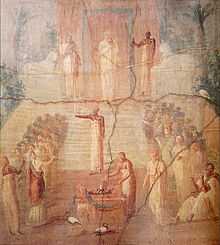Pelusia

In the Roman Empire, the Pelusia was a religious festival held March 20[3] in honor of Isis and her child Harpocrates. It would have coincided with the second day of the Quinquatria, a five-day festival to Minerva.[4] The holiday was not a part of the Roman calendar before the mid-1st century AD, but had been added by the time of Marcus Aurelius (161–180).[5] It is preserved in the Calendar of Filocalus (354 AD) as an official holiday.[6]
The Byzantine scholar John Lydus (6th century) explains the festival as commemorating the "mud" from the flooding of the Nile, which generates fertility and ends hunger and drought, and was probably thought to be embodied by the birth of Harpocrates, who in art is depicted emerging from mud and bearing a cornucopia.[7]

Participants in the Pelusia were sprinkled with water in order to obtain rebirth (regeneratio) and immunity from offenses to the gods (impunitas periurorum). The sprinkling is thought to mimic the symbolic effect of the flooding, and water from the Nile itself may have been used as a form of "holy water" as it was in other ceremonies of Isis brought to Rome. In Christian discourse of the time, regeneratio was used in connection with baptism. The Christian polemicist Tertullian (d. ca. 225) contrasts the rites of Pelusia with what he sees as the superior efficacy of baptism.[8]
In Egypt, the Pelusia of March 20 marked the beginning of the sailing season. The day was under the protection of Isis and Serapis.[9]
References
- ↑ Mary Beard, J.A. North, and S.R.F. Price, Religions of Rome: A Sourcebook (Cambridge University Press, 1998), vol. 2, p. 303; Everett Ferguson, Backgrounds of Early Christianity (Wm. B. Eerdmans, 1987, 3rd ed. 2003), p. 272.
- ↑ Roger Ling, Roman Painting (Cambridge University Press, 1991), p. 162.
- ↑ The date is given as March 24 in some secondary sources.
- ↑ R.E. Witt, Isis in the Ancient World (Johns Hopkins University Press, 1971, 1997), p. 123.
- ↑ Historia Augusta, Marcus Aurelius 23.8.
- ↑ Michele Renee Salzman, On Roman Time: The Codex Calendar of 354 and the Rhythms of Urban Life in Late Antiquity (University of California Press, 1990), pp. 125, 170, 174.
- ↑ Salzman, On Roman Time, pp. 174–175.
- ↑ Tertullian, De Baptismo 5.1; Fritz Graf, "Baptism and Greco-Roman Mystery Cults," in Ablution, Initiation, and Baptism: Late Antiquity, Early Judaism, and Early Christianity (De Gruyter, 2011), pp. 105–106, 108.
- ↑ J. Leclant and G. Clerc, Inventaire bibliographique des Isiaca (Brill, 1985), p. 9, summarizing Kurt Latte.
See also
- Isidis Navigium, the "sailing" festival of Isis on March 5
- Lychnapsia, lamp-lighting for Isis